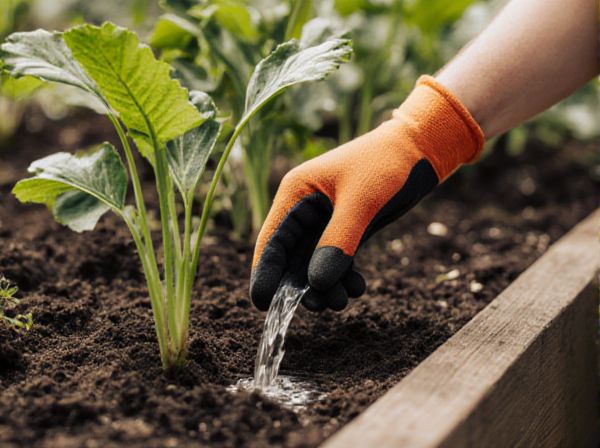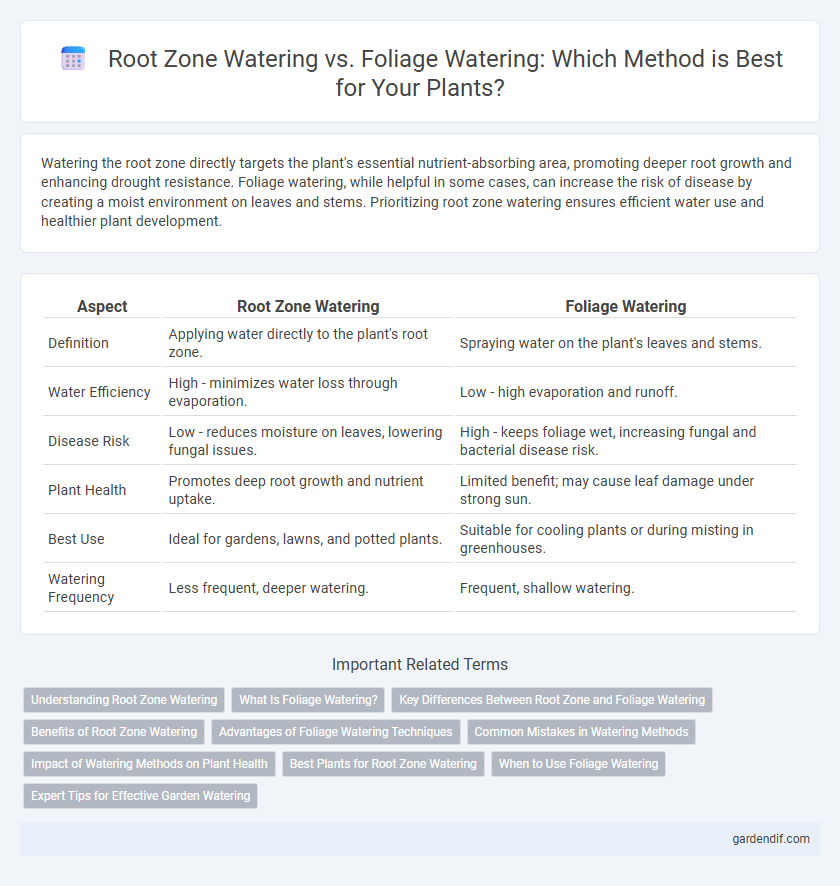
Root zone watering vs Foliage watering Illustration
Watering the root zone directly targets the plant's essential nutrient-absorbing area, promoting deeper root growth and enhancing drought resistance. Foliage watering, while helpful in some cases, can increase the risk of disease by creating a moist environment on leaves and stems. Prioritizing root zone watering ensures efficient water use and healthier plant development.
Table of Comparison
| Aspect | Root Zone Watering | Foliage Watering |
|---|---|---|
| Definition | Applying water directly to the plant's root zone. | Spraying water on the plant's leaves and stems. |
| Water Efficiency | High - minimizes water loss through evaporation. | Low - high evaporation and runoff. |
| Disease Risk | Low - reduces moisture on leaves, lowering fungal issues. | High - keeps foliage wet, increasing fungal and bacterial disease risk. |
| Plant Health | Promotes deep root growth and nutrient uptake. | Limited benefit; may cause leaf damage under strong sun. |
| Best Use | Ideal for gardens, lawns, and potted plants. | Suitable for cooling plants or during misting in greenhouses. |
| Watering Frequency | Less frequent, deeper watering. | Frequent, shallow watering. |
Understanding Root Zone Watering
Root zone watering targets the soil area directly surrounding plant roots, promoting deeper water absorption and reducing surface evaporation, which enhances plant health and drought resistance. This method ensures nutrients are efficiently delivered to the root system, supporting robust growth and minimizing fungal diseases commonly caused by wet foliage. By focusing irrigation efforts on the root zone, water conservation is optimized, resulting in improved yield for agricultural and horticultural practices.
What Is Foliage Watering?
Foliage watering involves applying water directly to the leaves and stems of plants, promoting surface hydration but often increasing the risk of fungal diseases due to prolonged leaf dampness. Unlike root zone watering, which delivers moisture directly to the soil where roots absorb nutrients, foliage watering mainly benefits certain tropical and ornamental plants that absorb water through their leaves. For optimal plant health, understanding the differences between foliage and root zone watering helps tailor irrigation techniques to species-specific needs and environmental conditions.
Key Differences Between Root Zone and Foliage Watering
Root zone watering targets the soil around plant roots, promoting deep moisture absorption and minimizing evaporation, which enhances overall plant health and growth. Foliage watering involves spraying water directly onto leaves, which can temporarily cool plants but may increase the risk of fungal diseases and does not efficiently hydrate the root system. The key differences lie in water delivery efficiency, disease risk, and plant hydration effectiveness, with root zone watering generally preferred for optimal plant development.
Benefits of Root Zone Watering
Root zone watering delivers moisture directly to the soil surrounding plant roots, enhancing water absorption efficiency and promoting deeper root growth. This method reduces surface evaporation and minimizes the risk of foliar diseases caused by wet leaves. By targeting the root zone, plants develop stronger, more drought-resistant systems, leading to improved overall health and growth.
Advantages of Foliage Watering Techniques
Foliage watering enhances photosynthesis by keeping leaf surfaces moist, which can improve plant growth and productivity. This technique reduces the risk of water runoff and soil erosion common in root zone watering, ensuring more efficient water use. Moreover, foliage watering can help control leaf temperature and minimize heat stress during hot weather conditions.
Common Mistakes in Watering Methods
Common mistakes in watering include over-wetting the foliage, which promotes fungal diseases and reduces photosynthesis efficiency. Root zone watering targets the soil directly, ensuring water reaches the plant's absorption area while conserving moisture and preventing surface runoff. Neglecting root zone irrigation often leads to shallow root systems and weak plant growth.
Impact of Watering Methods on Plant Health
Root zone watering delivers moisture directly to the soil where roots absorb it efficiently, promoting deeper root growth and reducing water waste. Foliage watering, often less effective, can increase the risk of fungal diseases by keeping leaves damp for extended periods. Prioritizing root zone watering enhances overall plant health by ensuring optimal hydration and minimizing pathogen exposure.
Best Plants for Root Zone Watering
Root zone watering delivers moisture directly to the soil surrounding plant roots, promoting deeper root growth and increased drought resistance. Best plants for root zone watering include deep-rooted varieties such as tomatoes, peppers, and fruit trees, which efficiently absorb water at the base, reducing foliage diseases caused by wet leaves. This method conserves water by minimizing evaporation and targeting the essential root area for optimal plant health.
When to Use Foliage Watering
Foliage watering is most effective during early morning or late afternoon when temperatures are cooler to minimize leaf burn and promote better absorption. It is ideal for plants that benefit from increased humidity or need foliar feeding through nutrient sprays. Avoid foliage watering in direct midday sun to prevent water droplets from acting as magnifying lenses that can damage leaves.
Expert Tips for Effective Garden Watering
Expert tips for effective garden watering emphasize root zone watering over foliage watering to enhance water absorption and reduce disease risk. Targeting the root zone ensures deep soil penetration, promoting stronger, healthier plant growth and conserving water by minimizing evaporation. Avoiding wet foliage helps prevent fungal infections, making root zone irrigation the most efficient method for garden watering.
Root zone watering vs Foliage watering Infographic

 gardendif.com
gardendif.com